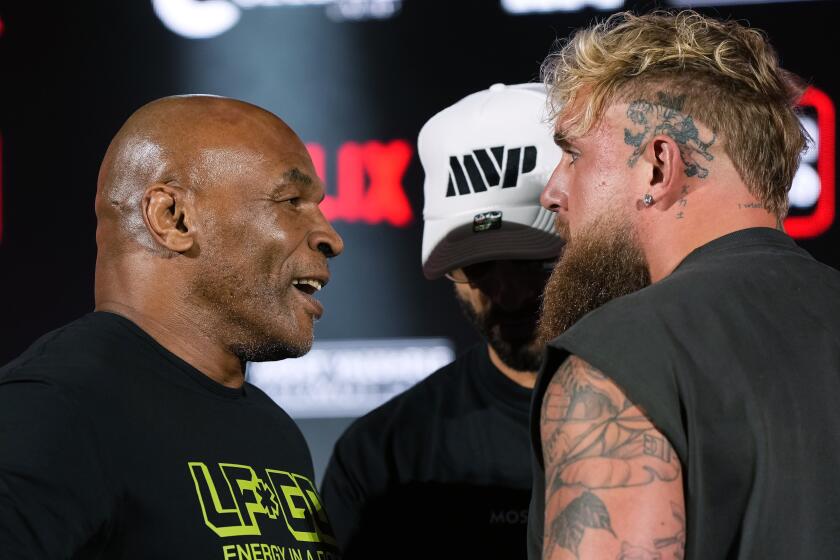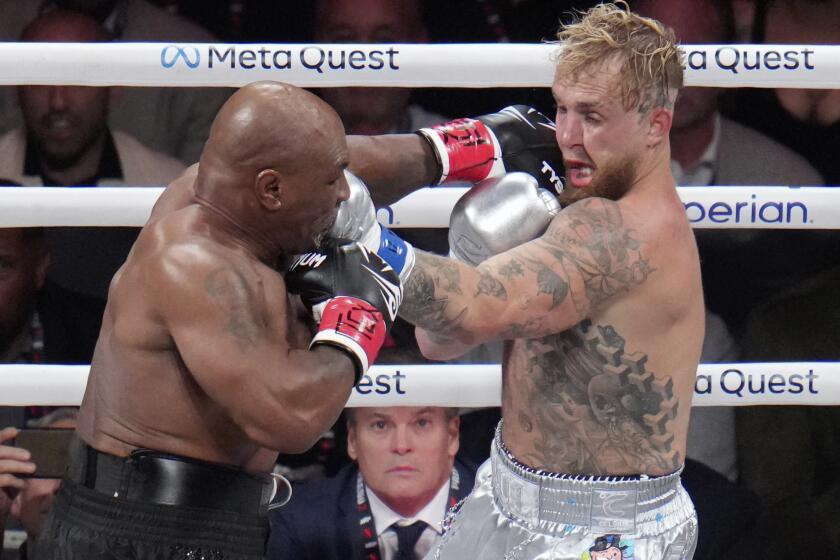Mosley Gets an Oscar
Boxing is no sweet science. That’s what A.J. Liebling called it. I’m not sure if he was the first, although he is the one who wrote a book about the sport by that title. In any event, there is nothing either sweet or scientific about it.
There was a moment, however, in Saturday night’s fight at Staples Center between Sugar Shane Mosley and Oscar De La Hoya that transcended the basic and brutal nature of the sport.
In a 12th and final round that had begun as fast and furiously as any you’ll probably ever see, referee Lou Moret, responding to a slip first by Mosley and then by De La Hoya, stopped the clock and asked for a towel to wipe the wet spot.
De La Hoya went to one corner, Mosley the other.
De La Hoya smiled at Mosley. Mosley smiled at De La Hoya.
When Moret signaled for action to resume, the two fighters met at the center of the ring and tapped gloves, just as they had at the beginning of every round, a gesture of their ultimate respect for each other from start to finish.
I’m not sure Liebling used the right words to describe boxing, although I’ll give that sweet writer the benefit of the doubt. I’d love to be able to see a lot of things through his eyeglasses. But, for that moment, I’m pretty sure I knew what he was thinking.
*
They each earned it, the other’s respect. Mosley was declared the winner by a split decision to win the world’s welterweight championship. The result wasn’t that great a surprise when it was announced by Michael Buffer. I thought it could have gone either way.
After the 10th round, e movie producer Ron Shelton, who was sitting next to me, asked me how I had scored it so far.
“Even,” I said. “Five rounds for De La Hoya, five rounds for Mosley.”
He said he had it six-four for Mosley.
“But it could be five-five,” he said. “Or it could be 6-4 the other way [De La Hoya].”
When the fight was over, I still had it even. Is that the safe way out or what? But my scoring was not a sign of ambivalence but of having seen at least three rounds in which each fighter fought so skillfully, competitively and bravely that they were almost impossible to call.
The ninth was like that, in particular. That wasn’t long after I had given up on Mosley. After taking everything De La Hoya had to offer and giving back more through the first four rounds, Mosley suddenly looked tired in the fifth. He looked even more so in the sixth, virtually giving away the round.
At that time, I could see the headline, “De La Hoya Stoops to Conquer.” He is listed at 5-foot-11 to Mosley’s 5-9. In fact, Mosley is closer to 5-7. But De La Hoya, except in the second and third rounds, didn’t use his great height advantage, choosing to lower his head and fight closer to Mosley’s level. It seemed to the ringsiders around me like a tactical error, but, midway through, he was clearly winning.
Never again after the sixth would Mosley fail to engage. He won the seventh and the eighth, and, in the ninth, he and De La Hoya fought one of those Hagler-Hearns type rounds that would have been remembered as one of the best anyone has seen in awhile--if the 12th hadn’t come along and been better.
We have long known De La Hoya as an artful fighter, one who has as dangerous a left hook as there is in the sport today but one who also can win aesthetically. OK, he is a sweet scientist.
Mosley, shorter and more compact, is considered more of a fighter. When Buffer says, “Let’s get ready to rumble,” Mosley is already ready. But in the ninth, he showed his ability to, like De La Hoya, switch from righty to southpaw and back again. No matter which hand was leading, though, De La Hoya had answers for it and vice versa.
*
Was it an upset?
Maybe to those who didn’t know better. Those of us who have followed Mosley’s career since he was a teenager in Pomona knew there wasn’t all that much difference between him and East L.A.’s De La Hoya. They were both seemingly en route to the Barcelona Olympics in 1992, but Mosley lost in the U.S. trials and De La Hoya went on to win in Spain and become “The Golden Boy.”
As Mosley said recently, “That put Oscar on the fast train; I was on the slow train.”
Still, they were destined to come together at Staples Center on Saturday night.
De La Hoya had experienced a lot more big fights. But Mosley was no novice--having fought one more time as a pro than De La Hoya--and wasn’t intimidated, even with the crowd about three-fourths in his opponent’s corner.
Any questions that anyone had about him as a fighter or as a welterweight in only his third bout at that weight, he answered. Any questions about De La Hoya’s courage after he ran the last three rounds in his only previous defeat, against Felix Trinidad Jr. last September, he answered.
In the final three rounds this time, knowing he was in a fight to the finish, he fought to the finish. The same was true for Mosley. There have been few closing rounds better than this one. They traded punches for the first minute, took a break when Moret stopped the action temporarily, and, thus renewed, traded punches for much of the remaining two minutes. When the final bell sounded, they hugged. It seemed genuine.
It might not have been sweet, but there was something beneath all the sweat and bruises and exhaustion that was beautiful about it.
*
Randy Harvey can be reached at his e-mail address: randy.harvey@latimes.com
More to Read
Go beyond the scoreboard
Get the latest on L.A.'s teams in the daily Sports Report newsletter.
You may occasionally receive promotional content from the Los Angeles Times.










